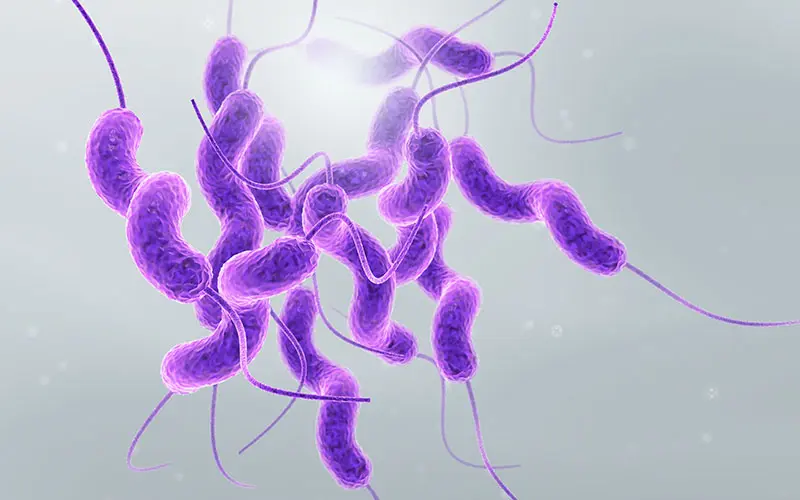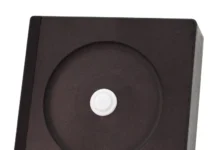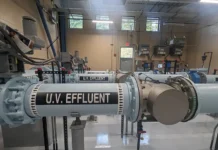Jim Bolton, Ph.D., president, Bolton Photosciences, Inc.
Gary Naarup, president, PremierOne Products, Inc.
Ultraviolet light in the UV-C region (particularly at 254 nm) has been widely applied to achieve the disinfection of drinking water and wastewater. Typical fluences (UV doses) for 4-logs inactivation are protozoa (10 mJ/cm2), bacteria (10 to 15 mJ/cm2) and viruses (20 to 160 mJ/cm2).
UV reactors have been installed from small units (e.g., 5 gpm) for point-of-use applications to large water utilities (up to 6 million gpm).
Recently, there have been some reports that blue light, particularly 405 nm light from LEDs, can achieve some level of disinfection. This article examines this new disinfection application.
Disinfection studies using near UV and blue (405 nm) LEDs
Using UV LEDs, (Mori et al. 2007) compared the disinfection efficiency of 365 nm and 405 nm light for the inactivation of E. coli (DH5α), Vibrio parahaemolyticus (RMID0509829), Staphylococcus aureus (RMID3112001) and Salmonella enterica (serovar Enteritidis). With the
365 nm UV LED, they found a 4-log inactivation of E. coli required a fluence of about 50 J/cm2. Using a 405 nm LED, the corresponding fluence was over 5,000 J/cm2. For comparison, a 4-log inactivation of E. coli at 254 nm (emission wavelength of a low-pressure mercury UV lamp) requires a fluence of only 6 to 10 mJ/cm2 (Malayeri et al. 2016).
Murdoch et al. (2010) examined the disinfection efficiency of 405 nm light for the inactivation of E. coli (O157:H7), Salmonella enteritidis and Campylobacter jejuni. The 4-log inactivations were at fluences of 250 J/cm2 (E. coli), 325 J/cm2 (Salmonella enteritidis) and 20 J/cm2 (Campylobacter jejuni).
Maclean et al. (2014) reviewed the literature for 405 nm LED disinfection technology as specially applied to hospital acquired infections (HAI).
McDonald et al. (2014) examined the disinfection of osteoblasts and found that, with a 405 nm fluence of 54 J/cm2, they achieved 98% inactivation of Staphylococcus aureus and 83% inactivation of Staphylococcus epidermis seeded on agar surfaces.
Hönes et al. (2015) compared the disinfection efficacy of 405 nm and 460 nm LEDs in the inactivation of E. coli and B. subtilis spores. They found that, after application of a fluence of 600 J/cm2 to E. coli, the inactivation level was 3.8-logs at 405 nm and 1.2-logs at 460 nm.
In the case of B. subtilis, the corresponding inactivation levels at a fluence of 300 J/cm2 were 4.3-logs at 405 nm and 3.0-logs at 460 nm. They speculated that the inactivation mechanism at 405 nm is absorption of light by porphyrins, which then undergo a photooxidation to form reactive oxygen species (ROS), which then attack and oxidize cell components.
Lui et al. (2016) carried out an extensive study of the inactivation of E. coli and E. faecalis using a variety of LEDs from 270 to 740 nm. They found little inactivation for wavelengths >455 nm.
For an E. coli inactivation level of 1.0-log, the fluences (in J/cm2) were 0.0006 (270 nm), 25 (365 nm), 61 (385 nm), 86 (405 nm), 100 (430 nm) and 300 (455 nm).
For E. faecalis, the corresponding fluences were 0.005 (270 nm), 42 (365 nm), 81 (385 nm), 130 (405 nm), 190 (430 nm) and 410 (455 nm).
Conclusions
It appears that 405 nm light can achieve inactivation of many bacteria; however, the fluences required for 1-log inactivation are very high (60 to 120 J/cm2). By contrast, the fluence required for 1-log inactivation at 254 nm is only about 0.002 J/cm2. To put this in perspective, if the 405 nm irradiance on a surface is 10 mW/cm2, it would take an exposure time of 10,000 s, or almost three hours, to achieve a fluence of 100 J/cm2.
Contact: Jim Bolton, jbolton@boltonuv.com; Gary Naarup, gary@premieroneproducts.com
References
- Hönes, K.; Stang, F.; Sift, M.; Hessling, M. (2015), Visible optical radiation generates bactericidal effect applicable for inactivation of health care associated germs demonstrated by inactivation of E. coli and B. subtilis using 405 nm and 460 nm light emitting diodes, in Novel Biophotonics Techniques and Applications III, Amelink, A.; Vitkin, A., Eds., Proc. of SPIE-OSA Biomedical Optics, SPIE, Vol. 9540, 95400T.
- Lui, G. Y.; Roser, D.; Corkish, R.; Ashbolt, N. J.; Stuetz, R. (2016) Point-of-use water disinfection using ultraviolet and visible light-emitting diodes, Sci. Total Environ., 553: 626–635.
- Maclean, M.; McKenzie, K.; Anderson, J. G.; Gettinby, G.; MacGregor, S. J. (2014), 405 nm light technology for the inactivation of pathogens and its potential role for environmental disinfection and infection control, J. Hosp. Infect., 88: 1–11.
- Malayeri, A. H.; Mohseni, M.; Cairns, B.; Bolton, J. R. (2016), Fluence (UV dose) required to achieve incremental log inactivation of bacteria, protozoa, viruses and algae, IUVA News, 18(3): 4–6.
- McDonald, R. D.; Gupta, S.; Maclean, M.; Ramakrishnan, P.; Anderson, J G.; MacGregor, S. J.; Meek, R. M. D.; Grant, M. (2014), 405 nm light exposure of osteoblasts and inactivation of bacterial isolates from arthroplasty patients: potential for new disinfection applications? Eur. Cells Mater., 25: 204–214.
- Mori, M.; Hamamoto, A.; Takahashi, A.; Nakano, M.; Wakikawa, N.; Tachibana, S.; Ikehara, T.; Nakaya, Y.; Akutagawa, M.; Kinouchi, Y. (2007), Development of a new water sterilization device with a 365 nm UV-LED, Med. Bio. Eng. Comput. 45: 1237–1241.
- Murdoch, L. E.; Maclean, M.; MacGregor, S. J.; Anderson, J. G. (2010), Inactivation of Campylobacter jejuni by exposure to high-intensity 405 nm visible light, Foodborne Pathogens and Disease, 7(10): 1211–1216.






